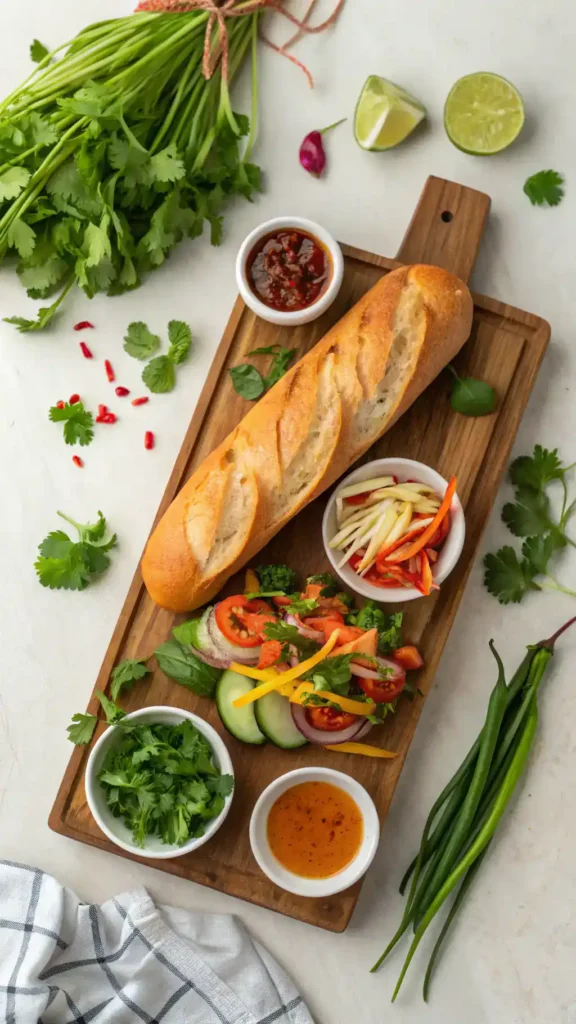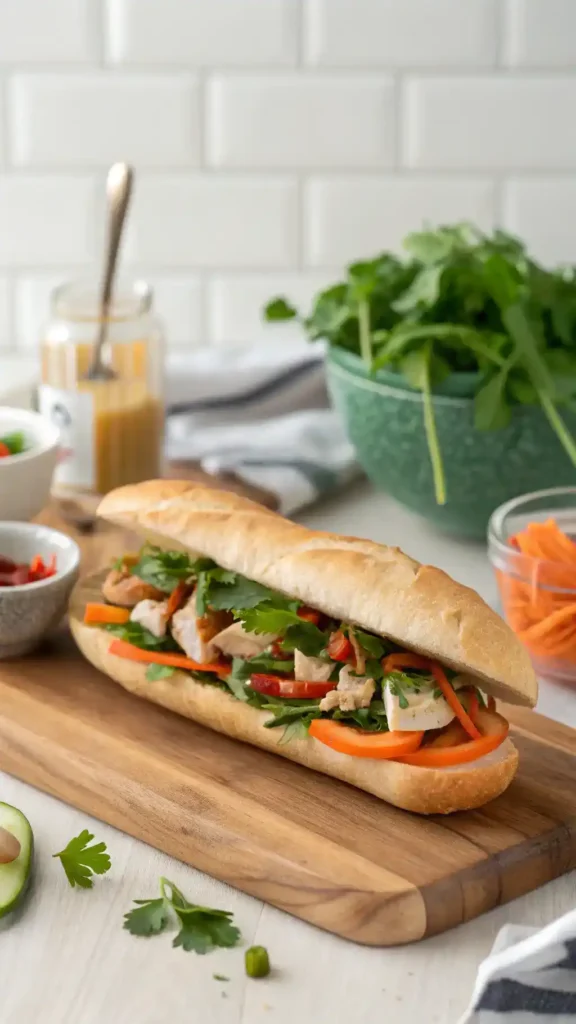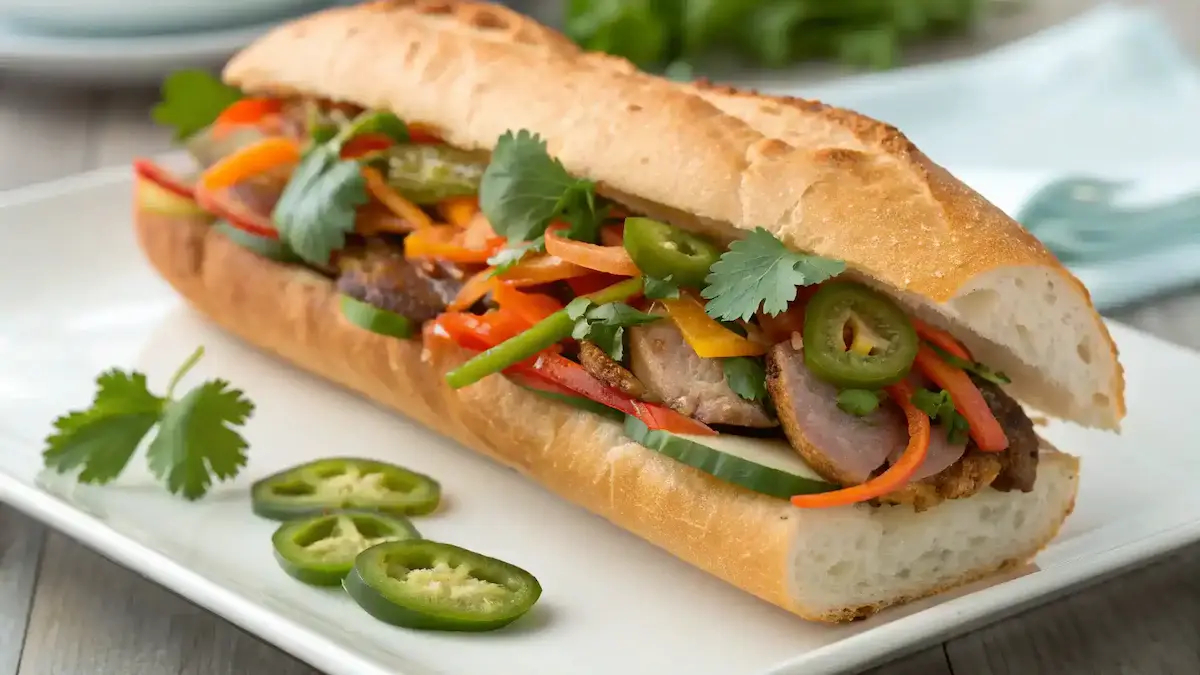Have you ever tasted a Banh Mi? This flavorful sandwich is a delightful fusion of Vietnamese cuisine and fresh ingredients. Making Banh Mi at home not only allows you to customize it to your taste but also offers a rewarding culinary experience. You can explore various protein options, like pork, chicken, or even tofu, while enjoying the nutritional value of fresh herbs and pickled vegetables. So, let’s dive into the world of Banh Mi and learn how to create this delicious treat right in your kitchen!

Banh Mi
Equipment
- 1 Oven For toasting the baguette.
- 1 Grill or Pan For cooking the protein.
- 1 Mixing bowl For marinating and pickling.
- 1 Knife For slicing vegetables and baguette.
Ingredients
Baguette
- 1 piece Vietnamese-style baguette Light and crispy with a crunchy crust.
Pickled Vegetables
- 1 cup Carrots and Daikon Radish Thinly sliced and pickled.
Protein Options
- 200 grams Marinated Pork or Chicken or Tofu Choose your favorite protein.
Fresh Herbs
- 1 handful Cilantro and Mint For freshness.
Spices
- 2 cloves Garlic Minced for flavor.
- 1 teaspoon Chili Adjust to taste.
Sauces
- 1 tablespoon Sriracha or Mayonnaise For creaminess and heat.
Instructions
Prepare the Ingredients
- Gather all your ingredients including the baguette, protein, pickled vegetables, fresh herbs, and spices.
Marinate the Protein
- Marinate the protein for at least 30 minutes using soy sauce, garlic, and sugar.
Pickle the Vegetables
- Mix vinegar and sugar, add sliced carrots and daikon, and let sit for 15 minutes.
Toast the Baguette
- Preheat the oven to 350°F (175°C), slice the baguette, and toast for 5-7 minutes.
Cook the Protein
- Cook the marinated protein until fully cooked, using your preferred method.
Assemble the Banh Mi
- Layer the protein, pickled vegetables, and fresh herbs in the toasted baguette.
Serve and Enjoy
- Cut the Banh Mi in half and serve immediately.
Video
Table of Contents
Key Benefits of Banh Mi
If you’re looking for a flavorful sandwich that’s both satisfying and nutritious, Banh Mi is your answer! This Vietnamese delight is not just a meal; it’s a culinary experience that brings together a variety of fresh ingredients and bold flavors. Here are some key benefits of making Banh Mi at home:
- Fresh Ingredients: One of the best parts of Banh Mi is the use of fresh ingredients. You can customize your sandwich with crisp vegetables, aromatic herbs, and high-quality proteins. This ensures that every bite is bursting with flavor.
- Nutritional Value: Banh Mi can be a healthy option. By choosing lean proteins like chicken or tofu, and loading up on veggies, you create a balanced meal that’s both delicious and nutritious.
- Flavorful Sandwich: The combination of marinated meats, pickled vegetables, and fresh herbs creates a symphony of flavors. Each ingredient plays a role in achieving that perfect balance, making every Banh Mi unique.
- Culinary Traditions: Making Banh Mi at home allows you to connect with Vietnamese cuisine. You’ll learn about its rich culinary traditions while enjoying the process of creating something special.
- Customization: When you make Banh Mi yourself, you can tailor it to your dietary preferences. Whether you’re vegan, vegetarian, or a meat lover, there’s a Banh Mi for everyone!
So, why not embark on this delicious journey? Making Banh Mi at home not only enhances your cooking skills but also allows you to enjoy a delightful meal that’s packed with flavor and nutrition.
Ingredients for Authentic Banh Mi
Creating a delicious Banh Mi at home starts with selecting the right ingredients. Each component plays a vital role in achieving that perfect balance of flavors and textures. Here’s what you’ll need:
- Baguette: Look for a light, crispy baguette. A Vietnamese-style baguette is ideal, but a French baguette works too. The key is a crunchy crust and a soft interior.
- Pickled Vegetables: Traditional Banh Mi includes pickled carrots and daikon radish. You can easily make these at home by soaking them in a mixture of vinegar, sugar, and salt. Alternatively, store-bought options are available.
- Protein Options: Choose your favorite protein! Popular choices include marinated pork, grilled chicken, or even tofu for a vegetarian option. Marinating your protein enhances the flavor significantly.
- Fresh Herbs: Don’t skip the herbs! Fresh cilantro and mint add a burst of freshness. You can also include Thai basil for an extra layer of flavor.
- Spices: Garlic and chili are essential for that authentic kick. Feel free to adjust the spice level to suit your taste.
- Sauces: A drizzle of Sriracha or mayonnaise adds creaminess and heat. You can also experiment with hoisin sauce for a sweet touch.

When selecting your ingredients, always opt for fresh, high-quality options. This not only enhances the flavor but also elevates the nutritional value of your Banh Mi. If you’re looking for substitutions, consider using grilled vegetables or different types of bread to cater to dietary preferences. Remember, the beauty of making Banh Mi at home is the ability to customize it to your liking!
How to Make Banh Mi
Making Banh Mi at home is a delightful culinary adventure. Follow this step-by-step guide to create your own flavorful sandwich. You’ll enjoy the process, and the results will be delicious!
- Prepare the Ingredients: Start by gathering all your ingredients. You’ll need a fresh baguette, your choice of protein (like pork, chicken, or tofu), pickled vegetables, fresh herbs (cilantro and mint), and spices (garlic and chili). Using fresh ingredients is key to achieving authentic flavors.
- Marinate the Protein: If you’re using meat, marinate it for at least 30 minutes. Combine soy sauce, garlic, and a bit of sugar for a balanced flavor. For tofu, a similar marinade works wonders. This step enhances the taste and ensures your Banh Mi is packed with flavor.
- Pickle the Vegetables: Prepare your pickled vegetables by mixing equal parts vinegar and sugar. Add thinly sliced carrots and daikon radish. Let them sit for at least 15 minutes. This quick pickling adds a refreshing crunch to your Banh Mi.
- Toast the Baguette: Preheat your oven to 350°F (175°C). Slice the baguette lengthwise, but don’t cut all the way through. Toast it for about 5-7 minutes until it’s crispy on the outside. This step is crucial to avoid a soggy sandwich.
- Cook the Protein: While the baguette is toasting, cook your marinated protein. Grill, pan-fry, or bake it until fully cooked. If you’re using tofu, pan-frying gives it a nice texture. This step adds depth to the flavors in your Banh Mi.
- Assemble the Banh Mi: Start layering your ingredients. First, add the protein, then the pickled vegetables, and finally, top with fresh herbs. Don’t forget to drizzle some Sriracha for a spicy kick! Layering is important for balancing flavors.
- Serve and Enjoy: Cut your Banh Mi in half for easier handling. Serve it immediately for the best experience. Pair it with a refreshing drink, and enjoy your homemade creation!

By following these steps, you’ll create a delicious Banh Mi that showcases the vibrant flavors of Vietnamese cuisine. Remember, the key is in the fresh ingredients and careful assembly. Enjoy your culinary experience!
Pro Tips, Variations, and Common Problems
Making Banh Mi at home can be a delightful culinary adventure. However, it’s essential to keep a few pro tips in mind to ensure your sandwich turns out perfectly every time. Here are some expert insights to elevate your Banh Mi game:
Pro Tips
- Choose the Right Baguette: Opt for a light, airy baguette. A crusty exterior with a soft interior is ideal. If you can’t find Vietnamese baguettes, a French baguette will work in a pinch.
- Marinate for Flavor: When using proteins like pork or chicken, marinate them for at least 30 minutes. This step enhances the flavor and tenderness of your meat.
- Toast the Baguette: Lightly toasting the baguette adds a delightful crunch. Just a few minutes in the oven will do the trick!
- Balance Your Flavors: Ensure you have a mix of savory, sweet, and tangy elements. The pickled vegetables should provide a refreshing contrast to the richness of the protein.
- Fresh Herbs Matter: Don’t skimp on fresh herbs like cilantro and mint. They add brightness and depth to your Banh Mi.
Creative Variations
Feel free to personalize your Banh Mi! Here are some tasty variations:
- Vegetarian Delight: Substitute the protein with marinated tofu or tempeh. This option is not only delicious but also caters to plant-based diets.
- Spicy Twist: Add sliced jalapeños or a drizzle of Sriracha for an extra kick. Adjust the heat to your preference!
- Different Proteins: Experiment with grilled chicken, beef, or even shrimp. Each protein brings its unique flavor profile to the sandwich.
- Sweet and Savory: Incorporate a touch of hoisin sauce or a smear of peanut butter for a sweet twist.
Common Problems and Solutions
Even the best chefs face challenges when making Banh Mi. Here are some common issues and how to solve them:
- Soggy Bread: To avoid this, ensure your pickled vegetables are well-drained. Additionally, toasting the baguette helps maintain its crispness.
- Overcooked Protein: Keep an eye on your cooking time. Use a meat thermometer to ensure your protein is cooked through but still juicy.
- Unbalanced Flavors: If your Banh Mi tastes flat, consider adding more pickled vegetables or a splash of lime juice. This adjustment can brighten the overall flavor.
- Too Much Filling: While it’s tempting to pile on the ingredients, be cautious. Overstuffing can lead to a messy sandwich. Aim for a balanced amount of each component.
By following these tips and being mindful of common pitfalls, you’ll create a flavorful Banh Mi that’s sure to impress. Enjoy the process, and don’t hesitate to experiment with your favorite ingredients!
Serving Suggestions for Banh Mi
When it comes to serving Banh Mi, presentation is key. This flavorful sandwich deserves a spot on the table that highlights its vibrant colors and fresh ingredients. Here are some delightful serving suggestions to elevate your Banh Mi experience.
Plating Ideas
Start by slicing your Banh Mi diagonally. This not only makes it easier to handle but also showcases the beautiful layers inside. Consider using a rustic wooden board or a colorful ceramic plate for an inviting look. Additionally, you can garnish the plate with fresh herbs like cilantro or mint. This adds a pop of color and enhances the aromatic experience.
Side Dish Pairings
To complement your Banh Mi, serve it alongside some traditional Vietnamese sides. Here are a few ideas:
- Vietnamese Spring Rolls: These fresh rolls filled with shrimp, herbs, and vermicelli noodles are light and refreshing.
- Pickled Vegetables: A small bowl of pickled carrots and daikon radish can enhance the meal’s flavor profile.
- Chips or Crispy Fried Tofu: For a crunchy contrast, consider serving crispy chips or tofu on the side.
Creative Serving Options
Whether you’re hosting a casual gathering or a more elegant dinner, Banh Mi can fit any occasion:
- Casual Setting: Serve Banh Mi in a picnic-style setting. Lay out a spread of various proteins and toppings, allowing guests to customize their sandwiches.
- Elegant Dinner: For a more refined presentation, stack the Banh Mi vertically on a sleek plate. Pair it with a glass of chilled white wine or a refreshing iced tea.
- Family-Style: Place a large platter of Banh Mi in the center of the table. This encourages sharing and creates a warm, communal atmosphere.
Presentation Tips
To make your Banh Mi truly stand out, consider these presentation tips:
- Use colorful garnishes like sliced jalapeños or a sprinkle of sesame seeds for added visual appeal.
- Drizzle a bit of Sriracha or hoisin sauce on the plate for a touch of elegance.
- Serve with a side of fresh lime wedges. This not only looks appealing but also adds a zesty kick when squeezed over the sandwich.
By incorporating these serving suggestions, your Banh Mi will not only taste incredible but also look stunning on the table. Enjoy the culinary experience and impress your guests with this delightful Vietnamese cuisine!
Preserving and Reheating Banh Mi
When it comes to enjoying your homemade Banh Mi days later, proper storage and reheating are key. First, let’s talk about how to store this flavorful sandwich to maintain its deliciousness.
Storage Tips
To keep your Banh Mi fresh, wrap it tightly in parchment paper or foil. Then, place it in an airtight container or a resealable plastic bag. This method helps prevent the bread from getting soggy while keeping the fillings intact. If you plan to eat it within a couple of days, store it in the refrigerator. Banh Mi can last about 2-3 days in the fridge. However, if you want to keep it longer, consider freezing it. When properly wrapped, Banh Mi can be frozen for up to 3 months. Just remember to remove as much air as possible to avoid freezer burn. For added freshness, vacuum-sealing is an excellent option.
Food safety is crucial, so always ensure your Banh Mi is cooled to room temperature before storing it. This practice helps prevent condensation, which can lead to spoilage or bacterial growth. Additionally, if you’re using perishable ingredients like meats or mayonnaise, consume your Banh Mi within the recommended timeframes to stay safe.
Reheating Methods
Now, let’s dive into reheating your Banh Mi without sacrificing its delightful texture and flavor. The oven is one of the best methods for reheating. Preheat your oven to 350°F (175°C). Wrap your Banh Mi in aluminum foil to keep it from drying out. Place it in the oven for about 10-15 minutes. This method warms the sandwich evenly while keeping the bread crusty.
If you’re short on time, the stovetop is another great option. Heat a skillet over medium heat. Unwrap your Banh Mi and place it in the skillet for about 3-4 minutes on each side. This technique gives you a crispy exterior while warming the inside.
While the microwave is convenient, it can lead to a soggy sandwich. If you must use it, place a damp paper towel over the Banh Mi and heat it in 30-second intervals until warm. This method adds moisture back into the bread.
For those with an air fryer, you can reheat your Banh Mi at 350°F (175°C) for about 5-7 minutes. This method crisps up the bread beautifully while warming the fillings. Regardless of the method you choose, always check the internal temperature to ensure it’s heated through.
By following these storage and reheating tips, you can enjoy your Banh Mi just as much as the day you made it. So, go ahead and savor every bite, whether it’s fresh or reheated!
Conclusion
As you wrap up your culinary adventure with homemade Banh Mi, let’s take a moment to appreciate the delightful journey you’ve just embarked on. This flavorful sandwich, rooted in Vietnamese cuisine, combines fresh ingredients like pickled vegetables, aromatic herbs, and your choice of protein, whether it be succulent pork, tender chicken, or even tofu. The simplicity and versatility of Banh Mi make it an excellent choice for both novice and experienced cooks alike. So, don’t hesitate to try making this delicious dish yourself!
We would love to hear about your experience! Feel free to share your results or ask any questions you might have. Remember, cooking is all about exploration and creativity. You can experiment with different ingredients or pairings to personalize your Banh Mi, making it truly your own. Whether you choose to add a spicy kick with Sriracha or keep it classic, the possibilities are endless.
Ultimately, making Banh Mi at home is not just about the food; it’s about enjoying the process and discovering the joy of cooking. So, gather your fresh ingredients, roll up your sleeves, and dive into this flavorful experience. Happy cooking!
Frequently Asked Questions About Banh Mi
Curious about making Banh Mi at home? Here are some common questions and helpful answers to guide you through this flavorful Vietnamese sandwich experience.
1. What is Banh Mi?
Banh Mi is a Vietnamese sandwich that combines a crispy baguette with various fillings, including meats, pickled vegetables, and fresh herbs. It’s a delightful blend of flavors and textures, making it a popular choice in Vietnamese cuisine.
2. What kind of bread is used for Banh Mi?
The traditional bread for Banh Mi is a light, airy baguette. It should have a crispy crust and a soft interior. You can find these at Asian grocery stores or bake your own for the best results.
3. Can I make Banh Mi vegetarian?
Absolutely! You can use tofu or tempeh as protein options. Additionally, load up on fresh vegetables and herbs to create a delicious vegetarian Banh Mi that still packs a flavorful punch.
4. How do I store leftover Banh Mi?
To keep your Banh Mi fresh, wrap it tightly in plastic wrap or foil. Store it in the refrigerator for up to two days. However, for the best taste, enjoy it fresh!
5. What are some common mistakes when making Banh Mi?
A common mistake is using soggy bread. To avoid this, toast the baguette lightly before assembling your sandwich. Additionally, balance your flavors by not overloading on any one ingredient, ensuring a harmonious taste.

